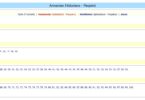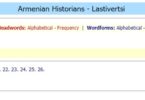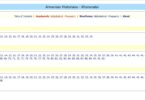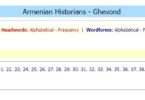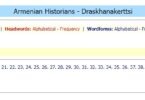Summary
Samuelian’s Talk on Language Instruction at the ANEC Teachers’ and Administrators’ Seminar, October 26, 1985
- An impromptu audience survey to assess the sociolinguistic conditions of the seminar and community yielded the following results: everyone was able to understand the presentation in English, though a few felt more comfortable expressing themselves in Armenian. The vast majority of Armenian language teachers are native speakers from the Middle East. The students are, on the whole, American-born, native speakers of English, who to a greater or lesser degree use Armenian at home. All agreed that the number of students coming to school with Armenian sufficient to express themselves is declining, and a no longer negligible majority of Armenian children have no command of Armenian and do not attend school.
- To know a language one must use it, and to use it, one must have a need to use it. While there are rare exceptions, in practice only those who use a language for daily interaction and education ever acquire and maintain the full-range of skills necessary to use a language as a means of communication. Native speakers are created by God and mothers, not schools. One corollary is that students who are not native speakers do not have the necessary exposure to the language outside the classroom to practice and acquire the skills they are exposed to in the classroom.
- The trickle down theory of language transmission. Linguistic output is but a fraction of total linguistic ability but if this serves as the main input for the next generation, then before long only a fraction of a fraction of a skill is transmitted.
- A language must be a real means of communication. Armenian is the lingua franca of the Armenian diaspora. [TS 2021 annotation: probably it was still the diasporan lingua franca in 1985, but in the intervening 35 years, English has overtaken Armenian as the lingua franca of the Armenian people worldwide]. When two Armenians have no other way of communicating, then the language is truly functioning as a means of communication. Language must be used as a vehicle for conducting our affairs and exchanging our thoughts before it can serve the other functions of national consciousness or solidarity. [TS 2021 annotation: A linguistic handshake, a greeting, toast, formulaic or ritualized speech, song or saying, may be sufficient for some degree of solidarity, but probably not for national consciousness.] Three situations when Armenian is functional: 1. Among Armenians who have no other common language in which to converse. 2. The church liturgy, 3. Reading untranslated works of Armenian literature and scholarship.
- Language is a vehicle for self-expression. One’s linguistic skill must be equal to the demands of expression, whether those of child with peers or those of an educated adult. If not, and if there is another language in which to communicate, the other language will be used.
- Language is not 1, but 4 or 5 kinds of knowledge: From most difficult to least difficult to teach: speaking, listening, writing, reading, appreciating the Armenian language as a creation of Armenian culture. Speaking, while spontaneously acquired as a child in an Armenian speaking community (not just a family but a whole community) is the most difficult to acquire for non-native speakers in a non-native environment. Reading, while not acquired spontaneously anywhere, is the most easily acquired skill.
- Learning languages in a non-native environment takes enormous amounts of time (1200+ hours of concentrated instruction and constant practice thereafter). In the Saturday school framework, there is not sufficient time to teach a language to non-native speakers. When time for festivals, vacations and school organization is deducted, we have at most 30 two-hour sessions – 60 hours a year for 7 or 8 years – for a maximum of 500 hours. Moreover, language skills rapidly deteriorate without constant use, and unless the skill is much more highly developed and automatic than we can create under the present circumstances, this deterioration shortly renders the skill inadequate or unsatisfying for the needs of real communication.
Conclusion: It is not a question of what we want to do, but what we can do in the amount of time we have at our disposal. Here are some points to bear in mind:
- Mission of the school is to create a sense of Armenian community through shared experiences and shared knowledge. The school is not only one of the important entry points into the community; it is part of the community. The school is a place to be Armenian together. The language classroom, however, is the classroom in which the student is most vulnerable and most easily alienated. Neither the school nor the student should be placed in a position of choosing between language skills and being part of the Armenian community.
- The native speakers who enter our school doors are a national treasure. To the extent that the students are willing, everything must be done to develop their skills so that they will have a true means of communication and self-expression adequate to their needs as adults. This is a tall, perhaps impossible, order to fill. In America even with 12 years or more of schooling in a native environment, literacy and good English skills are hard to develop. We must above all aim to equip students for future growth. What has happened predictable time and again is that students through no fault of their own or of the community, outgrow their Armenian language skills.
- Teaching one day a week. High and low investment courses. Courses, in particular language courses, can be designed for short- or long-term return on the students’ weekly investment of time and effort. As soon as students feel that the long-term goal is out of reach, they question the value of the investment. Thus, long-term methods cannot be transferred from the standard school to the one-day framework.
- Let’s start from the actual experience of the student and make it as rewarding and meaningful as possible. Our aim should be to orchestrate a series of tasks or experiences, the accomplishment of which is rewarding to the students and, taken as a whole, develops the students’ skills and prepares them to be enlightened members of the community. Our aim must be to help each student progress as far as he or she can in the 30 sessions each year. Obviously, students begin at different points and will reach different points, but each will have accomplished as much as he or she could in 30 sessions. The key to this approach is to start with what can be taught well in weekly two-hour sessions and strive to design series of two-hour sessions which will help the student progressively endow his or her world with Armenian meaning.
Language is a vehicle for a message, but the message is what is meaningful. We cannot afford to lose sight of the message; namely, a sense of belonging to the Armenian community, of being a part of Armenian history and culture. These aspects of culture can and should be taught well. All indications point to English as the language in which the students will be able to handle the necessary concepts and integrate this Armenian knowledge with other information they gain from the media and school. We handicap ourselves and the students when these topics are not taught in a language in which the students can understand them fully and discuss them intelligently. In short, we should let the need for the message set the agenda for teaching the language [TS 2021 annotation: and choice of the language of instruction].
Toward an Integrated Curriculum
60 hours a year. At the outset we must emphasize the mechanics of teaching and the limits that time and resources set on what can be taught. Whether we like it or not, for better or worse, we teach a certain number of basic points each time we meet with students. Our job is to make the succession of learning experience a means to the students’ progressive enlightenment and acquisition of Armenian culture. This means that the 30 sessions each year must interlock from week to week and must have some overall direction and structure. Whatever else the students might acquire in the way of enthusiasm for Armenian life or a more holistic understanding of Armenian culture – both of which are very important – the students must have a sense of accomplishment. Our time is limited – everything cannot be taught, and in any case, everything cannot be taught at once. We learn and teach topics one at a time. The point is to set priorities and aim for some kind of measurable mastery of the topics so that students will have a sense of progress and satisfaction.
To that end some very clear-cut goals must be set:
Cultural Literacy for Everyone
- the ability to answer the 101 most common questions about Armenian life: history, origins, church, culture, politics
- a solid hold on basic chronology of Armenian history and the correlation of Armenian events to worlds history – the construction of progressively more detailed timelines.
- The ability to associate various names and events, cultural works and their authors (e.g., lists of kings and generals to be matched to events, or put in chronological order)
- The ability to identify the major cities and geographic features of Armenian on the map. The places from which their ancestors came. Each year more and more detailed maps can be studied, drawn and labeled (start with rivers, mountains, province and major cities, perhaps 20 place names and aim for 100 after several years)
- The ability to explain the significance of the most important events of Armenian history (start with 20 events or periods – e.g., the founding of Erebuni/Urartu, the Armenian Persian Satrapy, Xenophon’s account of Alexander’s empire, Tigran’s Empire, the Roman wars, the Conversion to Christianity, the creation of the alphabet, the Arab period, the Bagratuni kingdom, the fall of Ani, the Seljuk invasion, the rise and fall of Cilicia, Ottoman rule, partitions of Armenia through history, Russian annexation, founding of political parties, massacres, Genocide, rise and fall of the Republic, Soviet Armenia, Armenian Diaspora [TS 2021 Annotation: restored Independence, Artsakh/Karabagh, new diaspora, Genocide Centennial/recognition], the students’ conceptualization of the shape of Armenian history)
- The ability to identify the most important Armenian authors and their works – Begin with biographies (associated with holidays or anniversaries) of a few important figures and progress to the reading and discussion of works of major authors either in the original or in English translation (Start with 20 or 30 and aim for 150 after several years)
- The ability to identify Armenian music, dance, artwork and monuments of Armenian Architecture – to explain what is characteristic of Armenian culture (pictures to be separated by style or era or simply to explain similarities and differences between Armenian from non-Armenian works and explain why)
- A familiarity with the major Armenian institutions of the Diaspora [TS 2021 annotation: the Republic of Armenia/Artsakh] and their current leaders, main aims and main achievements and areas of activity
- History of the Armenian language, relation to other languages, language appreciation, varieties of Armenian (East, West, classical, middle)
Language for non-native speakers
- The ability to perform simple conversational routines in Armenian, e.g., introductions, autobiographical information, greetings, dinner table talk, telling the time, saying the date, giving one’s age, counting . . .
- Knowledge of set texts – e.g., songs, prayers, poems, proverbs . . . All of which should be learned by heart and translated word for word so that the students know what they are saying, singing or reciting.
- The ability to recite, decipher, read and write the alphabet
- Vocabulary in coherent semantic groupings, e.g., foods, names, common objects, colors, etc. (a few in each category, augmented each year)
- Reading of annotated or parallel tests
The learning of facts is only the first stage in culture acquisition. But it is an essential stage. Facts are the building blocks out of which theories are made, trends charted, understanding acquired. Learning the facts is like clearing, marking out and tilling a filed. For the culture to grow it must be worked with, cultivated and nurtured. We must seek the significance of the facts for them to become meaningful and useful.
Integration of knowledge through discussions, constant cross-referencing between subjects and topics, reference backward and forward, preparing for quizzes and tests all help the student to make the material their own. Our aim is to help them endow their world with Armenian meaning. Play with the ideas and facts so that they do not remain inert things, but become the students’ everyday tools of understandings and sources of pleasure. Learning is a purposeful activity. Knowledge is an instrument we work to acquire or invent to cope with real needs. To the extent that it is possible, every lesson should have a concrete aim; namely, to overcome some obstacle to the students’ understanding. The teacher must create the obstacle, pique the students’ curiosity, convince that the obstacle is worth overcoming, then help them to overcome it by learning.
Samples:
- Lower Elementary: Why is your name Ara, Why is your name Anahid? Why is your name Dikran? What is your name Samuel? Where do these names come from? Read the stories. Find out the origin of everyone’s first and last name. At the earliest stages of learning, exposure to a culturally rich and varied curriculum is more effective than a more analytic approach to learning. Children simply become accustomed to what they are exposed to and that familiarity is a permanent basis for their sense of belonging to the Armenian community. Hence, above all else the school must be appealing. Reading or reciting to children should be a permanent and central part of the curriculum at this stage. Parents should be encouraged to read to their children as well. To this end teachers can tell the children Armenian stories, tales, poems and children’s rhymes by such writers as Toumanian, Shant, Aghaian, Zartarian, etc. If children hear them often enough, they will soon know them by heart. These classics of Armenian children’s literature are a national treasure. Take advantage of them! They work
- Upper Elementary: Why is our church name for St. Gregory? Who is St. Gregory? What did he do to deserve being remembered for so long? Who decided to call our church by this name? What other famous people are our churches named for? Who were they? When did they live, what did they do? What other saints do you know? How does one become a Saint? Or to use a more secular variant of the same kind of topic. Why is ____branch of some local organization named for ___. Who was this person? When was the local branch established? Who established it? When was the organization established? Who are the founders? What were their aims? How have those aims changed?
- Intermediate: Did you know that there are Greek (proskhume, orthi) Hebrew (amen, kahana) and Persian (hreshdag, vartabed) words in the Armenian Mass (Badarak is even a word of Persian origin)? What are they? What do they mean? Why would they be there? When and by whom was the Mass rendered into Armenian? What was used before then
- Literature for higher levels: Have you ever felt ____? What kinds of things did you feel? Why did you feel that way? What was the cause? Can you describe the feeling? What was it like? (introduce the notions of simile and metaphor). Well so did ___, who lived in ___ time and wrote this pome, story after ___ event. Let’s read it together. How doe you feel now that you have read the passage? Do you understand the feelings and reasons for those feelings? Do you think the writer is sincere, honest? Is the passage real? How do you know? How does the writer get you to feel those things? What images, events, situations, kinds of language does the writer use? Why are they appropriate? Do you think the passage has a different meaning for Armenians that for readers of other nationalities? Are the images and messages universal or are their references that can be best understood by an Armenian? Why? Literature should not be read and analyzed in this way before students are ready. Until they are ready, they should read for pleasure and for the story line.
- Where is Armenia today? Why is it part of the Soviet Union? When did it become part of the Soviet Union? What does it mean to be a republic of the Soviet Union? How is the country run and organized? What was the relationship between the Republic of Armenia and Soviet Armenian Republic? Identify the most important events and figures in both Armenian and Russian history of the last three centuries, but be sure that the students have a good hold on world history of this period. Make references to events in American history that were happening at the same time, to help the students get their bearings. Give a historical perspective on the relationship between Armenia and Russia since 1700. What international situations affected Armenian-Russian and Armenian Turkish relations (Timetables of History is a good source book for such presentations, as are historical atlases, e.g., those by Penguin NY Times, and the ANEC Historical Atlas of Armenia, and of course, Walker, Survival of a Nation for the modern period). Students should be encouraged to collect information for standard Western Civilization books, encyclopedia articles and present the evidence. Reenact the positions of the various countries and their policy makers. Find out what happened, and why things happened as they did. Should be like reports: who want, when where, why and how.
History should have the immediacy of current events. Our understanding of historical events should be as immediate as our life with the consequences of those events. In his sense, all history is either directly or indirectly relevant to the present. It is the key to our present life. And should be presented that way. It should have the authenticity of autobiography and should serve each individual as memory. The facts of history should be as second nature as the facts of own’s life story, of which it is an extension.


